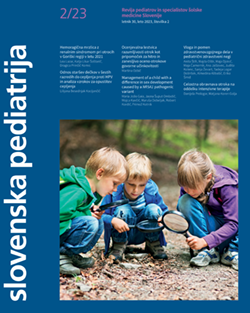
|
Article short contents
Slovenska pediatrija 2023; 30: 54-59
https://doi.org/10.38031/slovpediatr-2023-2-01en
|
: 263
Original scientific article
HEMORRHAGIC FEVER WITH RENAL SYNDROME IN CHILDREN OF THE GORIŠKA REGION IN 2021
Lea Lazar
Splošna bolnišnica dr. Franca Derganca Nova Gorica, Šempeter pri Novi Gorici, Slovenija
Katja Likar Šoštarič
Zdravstveni dom Ajdovščina, Ajdovščina, Slovenija
Dragica Prinčič Komic
Nacionalni inštitut za javno zdravje, Območna enota Nova Gorica, Nova Gorica, Slovenija
Abstract
Hantaviruses are spread worldwide and cause haemorrhagic fever with renal syndrome(HMRS). The two serotypes occurring in Slovenia are Puumala and Dobrava viruses. Puumala virus causes a milder disease, whereas Dobrava virus causes a more severe form. The transmission of the virus in Slovenija occurs mainly from mice to human hosts, giving the disease its second, colloquial name, »mice chills/mice fever«. The most common clinical presentation is fever with chills and headache. The most typical laboratory finding is thrombocytopenia, but in more severe cases, serum creatinine and urea levels can also be elevated. Serological tests such as indirect immunofluorescence (IIF) and ELISA (enzyme-linked immunosorbent assay) will detect specific IgM and IgG antibodies to confirm the diagnosis. The treatment is primarily supportive. In 2021 almost half of the cases of Hantavirus infections in Slovenia originated from the Goriška region. There were 24 cases of Hantavirus infection among children, 13 of which originated from the Goriška region, and nine of 13 needed hospital treatment. This article presents the incidence, clinical course, and treatment of Hantavirus infections at primary and secondary healthcare levels in children of the Goriška region in 2021.
Side note: The epidemiologic data for the year 2021 is preliminary
Key words: haemorrhagic fever with renal syndrome, Hantavirus infections, children, Slovenia